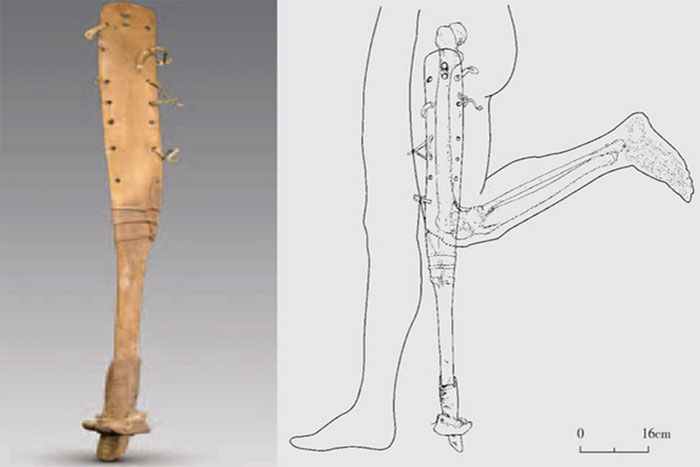2,200-year-old prosthesis in a tomb in China
Archaeologists found 2,200-year-old dating horseshoe prostheses buried with a man's remains in the cemetery near Turpan, China.
In the tomb, archaeologists found the remains of a man and a woman. The left leg of the deformed man, kneecap, the femur and tibia were fixed at an angle of 80 degrees. This man could not stretch his legs, leading to difficulty in walking. Therefore, the fake leg can make the movement of men more convenient.

The horseshoe-shaped prosthetic leg in a 2,200-year-old tomb in China.(Photo: Chinese Archaeological Institute).
The fake leg is made of birch wood . It has seven holes along the sides and a leather band to fix. The lower part of the leg is cylindrical, the end is wrapped with ox horn or horseshoe to increase friction.
According to two studies published in Bridging Eurasia in 2013 and Quaternary International in 2014, men are about 50 - 65 years old and about 1.7 meters tall. Causes of knee deformity can be arthritis, rheumatism or injury. Researchers said the man had suffered from pneumonia. This may also be the cause of bone deformity.
It is likely that the non-rich man because there is only one vase and ceramic cup, a wooden plate and a wooden bow. The tomb was opened later to bring the 20-year-old woman's body into. This affects his remains. The tomb is located in a population of 30 graves that archaeologists excavated in the cemetery.
The graves in the cemetery may belong to the Gushi ethnic people. This is a small state that appeared in the middle of the Western Han Dynasty, located in the Turfan River basin, China. Scientists at the local Turfanica Research Institute excavated the graveyard in 2007-2008.
- The secret of an ancient tomb is 800 years old in China
- The oldest 1,500-year-old wooden prosthesis in Europe
- China excavated the tomb of Qin Shihuang's grandmother
- Discovered 1,200-year-old ancient tomb in China
- Found a thousand-year-old beef soup in a tomb
- 2,000-year-old tomb in Mexico
- The tomb of 1,400 years contains a blue monster figure in China
- The mystery of the tomb Qin Shihuang
- Discover Swiss watch in a 400-year-old tomb in China
- Excavation of 800-year-old tomb, unexpectedly discovered precious treasures
- Ancient Chinese Tomb: Precious information about the ancient sacrifice
- China suspended excavation of the tomb of Qin Shi Huang
 Discovered an ancient centipede fossil 99 million years old
Discovered an ancient centipede fossil 99 million years old Discovered bat-like dinosaurs in China
Discovered bat-like dinosaurs in China Discovered a 200-year-old bronze cannon of the coast
Discovered a 200-year-old bronze cannon of the coast Discover 305 million-year-old spider fossils
Discover 305 million-year-old spider fossils Brian Shaw, the world's strongest man, makes even the biggest bodybuilders look small
Brian Shaw, the world's strongest man, makes even the biggest bodybuilders look small  2,400-year-old mummy so well preserved that scientists can get fingerprints
2,400-year-old mummy so well preserved that scientists can get fingerprints  Unsolved Criminal Mysteries of the 20th Century
Unsolved Criminal Mysteries of the 20th Century  'Dragon Man': Ancient Species Unleashes Mystery About Human Origin!
'Dragon Man': Ancient Species Unleashes Mystery About Human Origin!  The truth about Vietnam's strange 'tied her up' bird
The truth about Vietnam's strange 'tied her up' bird  Science 'tips' for women how to choose the ideal man
Science 'tips' for women how to choose the ideal man 